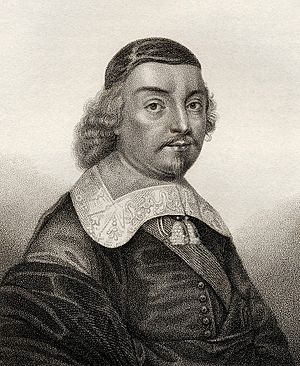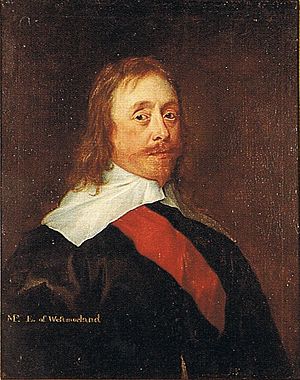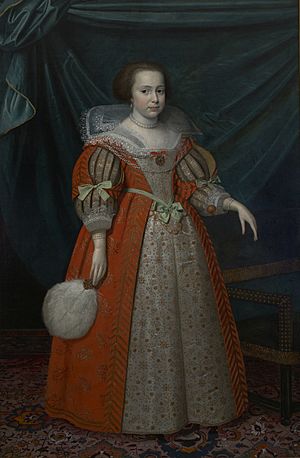Mildmay Fane, 2nd Earl of Westmorland facts for kids
Quick facts for kids
The Earl of Westmorland
|
|
|---|---|
 |
|
| Member of Parliament for Peterborough | |
| In office 1621–1624 Serving with Walter FitzWilliam
|
|
| Monarch | James I |
| Preceded by | Edward Wymarke Sir William Walter |
| Succeeded by | Sir Francis Fane Laurence Whitaker |
| In office 1626–1629 Serving with Laurence Whitaker
|
|
| Monarch | Charles I |
| Preceded by | Laurence Whitaker Sir Christopher Hatton |
| Succeeded by | None (parliament suspended until 1640) |
| Member of Parliament for Kent | |
| In office 1625–1625 Serving with Sir Albert Moreton
|
|
| Monarch | Charles I |
| Preceded by | Sir Nicholas Tufton Sir Edwin Sandys |
| Succeeded by | Sir Edward Hales Sir Edward Scot |
| Lord Lieutenant of Northamptonshire | |
| In office 1660–1666 Serving with The Earl of Exeter
|
|
| Monarch | Charles II |
| Preceded by | None (English Interregnum) |
| Succeeded by | The Earl of Exeter The Earl of Peterborough |
| Personal details | |
| Born |
Mildmay Fane
24 January 1602 Mereworth, Kent, England |
| Died | 12 February 1666 (aged 64) |
| Spouses | Grace Thornhurst (1620–36) Mary Vere (1638–66) |
| Children | With Grace Thornhurst Charles Fane, 3rd Earl of Westmorland With Mary Vere Lady Mary Fane Vere Fane, 4th Earl of Westmorland Rachael Fane Catherine Fane Susan Fane Elizabeth Fane |
| Parents | Francis Fane, 1st Earl of Westmorland Mary Mildmay |
| Alma mater | Emmanuel College, Cambridge |
| Occupation | Politician, writer |
| Awards | Knight of the Bath |
Mildmay Fane, 2nd Earl of Westmorland (born January 24, 1602 – died February 12, 1666) was an important English nobleman, politician, and writer. He was also known as Lord le Despenser for a few years. He lived during a very exciting time in English history.
Contents
Mildmay Fane's Early Life and Career
Mildmay Fane was one of seven sons born to Francis Fane and Mary Mildmay. He was born in Kent, England. He went to Emmanuel College, Cambridge to study.
He started his political career early. In 1620, he became a Member of Parliament (MP) for Peterborough. An MP is a person chosen to represent people in the country's government, called Parliament. He also served as an MP for Kent in 1625.
In 1629, he became the Earl of Westmorland and Lord le Despenser after his father passed away. This meant he inherited important titles and responsibilities.
His Role During the English Civil War
Mildmay Fane was a friend of the famous poet Robert Herrick. He supported King Charles I during the English Civil War. This war was a big conflict between the King and Parliament. King Charles I was even the godfather to Fane's oldest son.
However, Fane was briefly held by Parliament during the war. After this, he decided to leave politics for a while. He went to live quietly at his large home, Apethorpe Palace, in Northamptonshire.
Mildmay Fane's Creative Writing

Mildmay Fane was a very creative person. He wrote many poems. In 1648, he published a collection of 137 of his poems called Otia Sacra. This was special because he was the first English nobleman to publish his own poetry.
Later, in the late 1900s, even more of his poems were found. About 500 poems written by Fane between 1621 and 1665 were published in 2001. These poems were found in old handwritten collections.
His Plays and Masques
Fane also wrote plays and "masques." Masques were special shows that combined music, dance, and acting. Six of his plays were performed at his home, Apethorpe Palace, in the 1640s. His own children and servants acted in these shows!
For one of his masques, Candia Restaurata (from 1641), Fane designed the stage sets and special effects. He even wrote some of the music. His plays often had interesting characters. For example, Virtue's Triumph featured characters like Ambition, Lies, and Truth. Another play, De Pugna Animi, had a main character called Lord Mens (Mind) who fought against the five senses.
Fane wrote his play The Change while he was held in the Tower of London. He wrote over 900 poems in English and Latin. He also wrote eight plays or entertainments. One of his plays, Ladrones, was about famous explorers like Sir Francis Drake. However, the original handwritten copy of this play has been lost.
Mildmay Fane's Family Life
Mildmay Fane was married two times. His first wife was Grace Thornhurst, whom he married in 1620. They had one son and five daughters together.
After Grace passed away, he married Mary Vere in 1638. With Mary, he had another son and four daughters. His sons, Charles and Vere, both became Earls of Westmorland after him.
Other Talented Family Members
Mildmay Fane came from a talented family. His younger brother, Sir Francis Fane, was also a writer. He published poetry and three plays. He was a knight and served in the English Civil War.
Mildmay's sister, Rachael Fane, also lived at Apethorpe Palace. She wrote plays and masques too, which were performed by the family. Her writings are still around today in old manuscripts. Another younger brother, Colonel George Fane, was also a Royalist and an MP.
Plays and Masques by Mildmay Fane
- Raguaillo d'Oceano (1640)
- Candia Restaurata ("Candy Restored", 1641)
- Time's Trick Upon the Cards (1642)
- The Change (1642)
- Virtue's Triumph (1644)
- Don Phoebo's Triumph (1645)
- De Pugna Animi (1650)
- Ladrones, or the Robbers' Island (lost)


